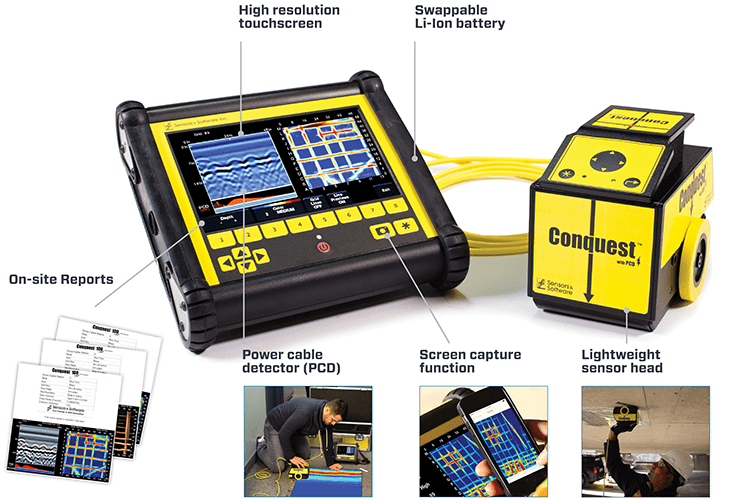Comprehensive Guide to Concrete Scanning Technologies
Comprehensive Guide to Concrete Scanning Technologies
Blog Article
Elevate Your Building Process With the Strategic Insights of Concrete Scanning for Enhanced Productivity
In the world of modern-day construction practices, the quest for efficiency and precision is paramount. Embracing innovative technologies has actually ended up being a cornerstone for attaining these objectives. One such modern technology that has actually transformed the construction industry is concrete scanning. By using the strategic understandings given by concrete scanning, building and construction experts can unlock a world of boosted efficiency and streamlined procedures. The effects of integrating concrete scanning go far past surface-level benefits, offering an extensive effect on project end results.

Advantages of Concrete Scanning
Enhancing job efficiency and safety and security, concrete scanning uses a non-destructive technique for spotting surprise things within concrete frameworks. By making use of modern technologies such as ground-penetrating radar (GPR) and concrete x-ray imaging, building groups can properly find rebar, post-tension cable televisions, electric channels, and various other obstructions prior to drilling, reducing, or coring into concrete.
The benefits of concrete scanning are many. Building and construction sites can be complicated environments, and understanding what exists under the surface area can stop accidents and injuries.
Furthermore, concrete scanning promotes overall project performance by protecting against and streamlining workflows rework. By identifying potential issues at an early stage, teams can adjust their plans proactively, saving time and resources in the future. Basically, the fostering of concrete scanning innovations is a calculated investment that pays dividends in terms of productivity, safety and security, and cost-effectiveness.
Technology Assimilation for Effectiveness
Concrete scanning's capacity to enhance process and improve task effectiveness can be additional optimized with critical combination of advanced technologies. By including Structure Information Modeling (BIM) software into concrete scanning procedures, building and construction teams can achieve a greater level of precision and sychronisation. BIM enables for the creation of 3D versions that offer detailed understandings into the task, allowing better decision-making and lowering the possibility of errors. Furthermore, the integration of Enhanced Fact (AR) modern technology with concrete scanning can improve on-site visualization, enabling project managers and employees to overlay digital details onto the physical atmosphere in real time. This can promote much more precise positioning of aspects and improve communication amongst employee. The use of drones for aerial studies in combination with concrete scanning can speed up information collection and analysis, allowing much faster decision-making and progress monitoring. On the whole, the tactical assimilation of these technologies can substantially boost effectiveness and performance in construction jobs.
Preventing Expensive Mistakes
Just how can meticulous focus to detail during concrete scanning continue reading this processes assist construction groups in preventing costly mistakes? By using innovative scanning technologies such as Ground Penetrating Radar (GPR) and electromagnetic induction, building and construction groups can accurately find rebar, utilities, voids, and various other blockages within concrete frameworks. Additionally, concrete scanning aids in making sure structural honesty by identifying weaknesses or defects in the concrete early on, allowing for prompt repairs and modifications.
Enhancing Task Management
Careful focus to information throughout concrete scanning processes not only assists in avoiding costly mistakes yet additionally lays a strong foundation for effective job administration in construction undertakings. By incorporating concrete scanning modern technology into project administration methods, building teams can improve process, boost interaction, and guarantee that great post to read jobs remain on track.
Concrete scanning offers valuable insights into the architectural stability of existing components, enabling project managers to make educated decisions pertaining to layout adjustments or building and construction sequences. This aggressive strategy minimizes the risk of unexpected hold-ups or remodel, inevitably conserving time and resources. In addition, the data acquired from concrete scanning can be integrated right into Structure Details Modeling (BIM) platforms, allowing real-time cooperation and sychronisation among various stakeholders.
Furthermore, concrete scanning aids project supervisors determine potential risks or challenges prior to they intensify into bigger concerns, promoting a more secure job setting for all involved. With improved exposure and accuracy given by concrete scanning technology, task supervisors can successfully plan, monitor, and execute building and construction jobs with greater efficiency and self-confidence.
Maximizing Productivity
One essential facet of making the most of efficiency is via the adoption of concrete scanning innovation. By making use of ground-penetrating radar (GPR) and other scanning methods, building groups can accurately locate rebar, channels, and various other subsurface components, lessening the threat of expensive errors and hold-ups throughout excavation and boring.
Additionally, welcoming Building Info Modeling (BIM) software application can considerably improve performance by developing detailed 3D models that enhance job visualization and control amongst various professions. BIM allows for better clash discovery, allowing concerns to be identified and fixed prior to building even begins, saving time and resources in the future.
Executing a lean building and construction strategy, which concentrates on removing from this source waste and maximizing performance throughout all project phases, is another reliable strategy for making the most of productivity. By fostering collaboration, communication, and continuous renovation, construction teams can work more cohesively towards achieving task goals in a effective and structured fashion.
Final Thought
To conclude, the tactical implementation of concrete scanning in the construction procedure uses many benefits, including raised effectiveness, cost savings, boosted job management, and boosted efficiency. By incorporating this innovation, building and construction teams can prevent expensive errors, improve their operations, and optimize their overall project outcome. Concrete scanning is an important tool that can boost the building procedure and cause more effective and lucrative outcomes.

Report this page